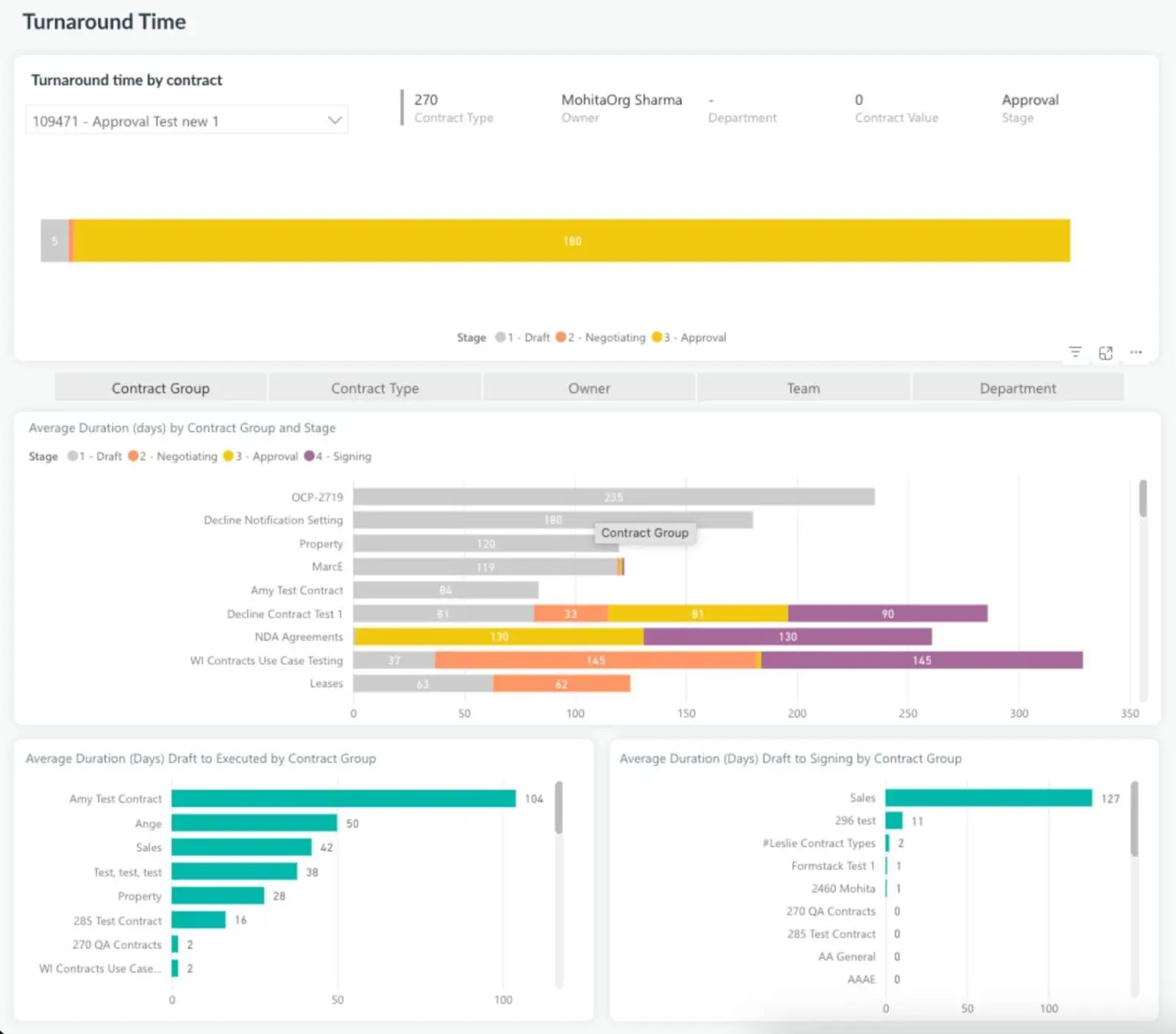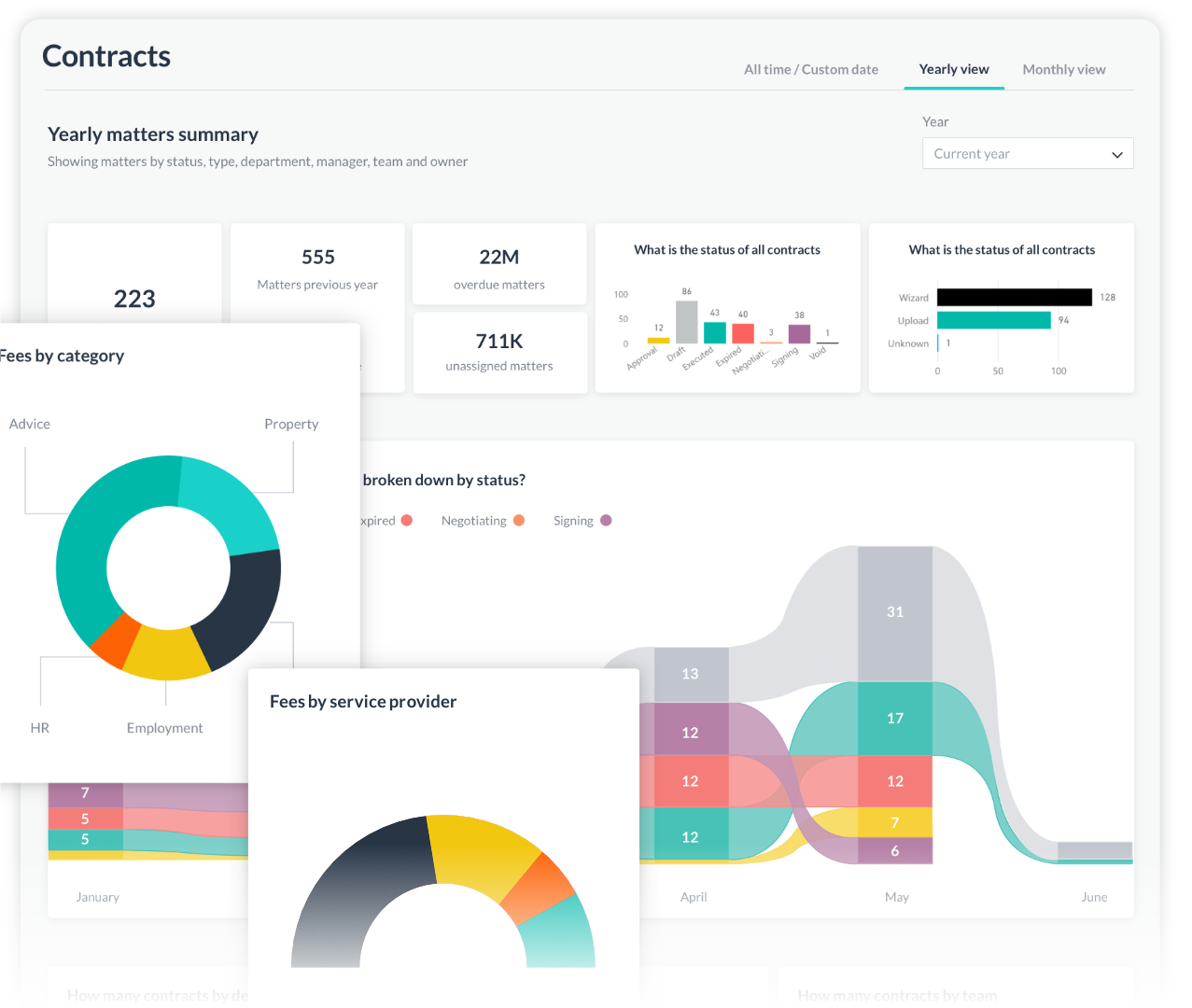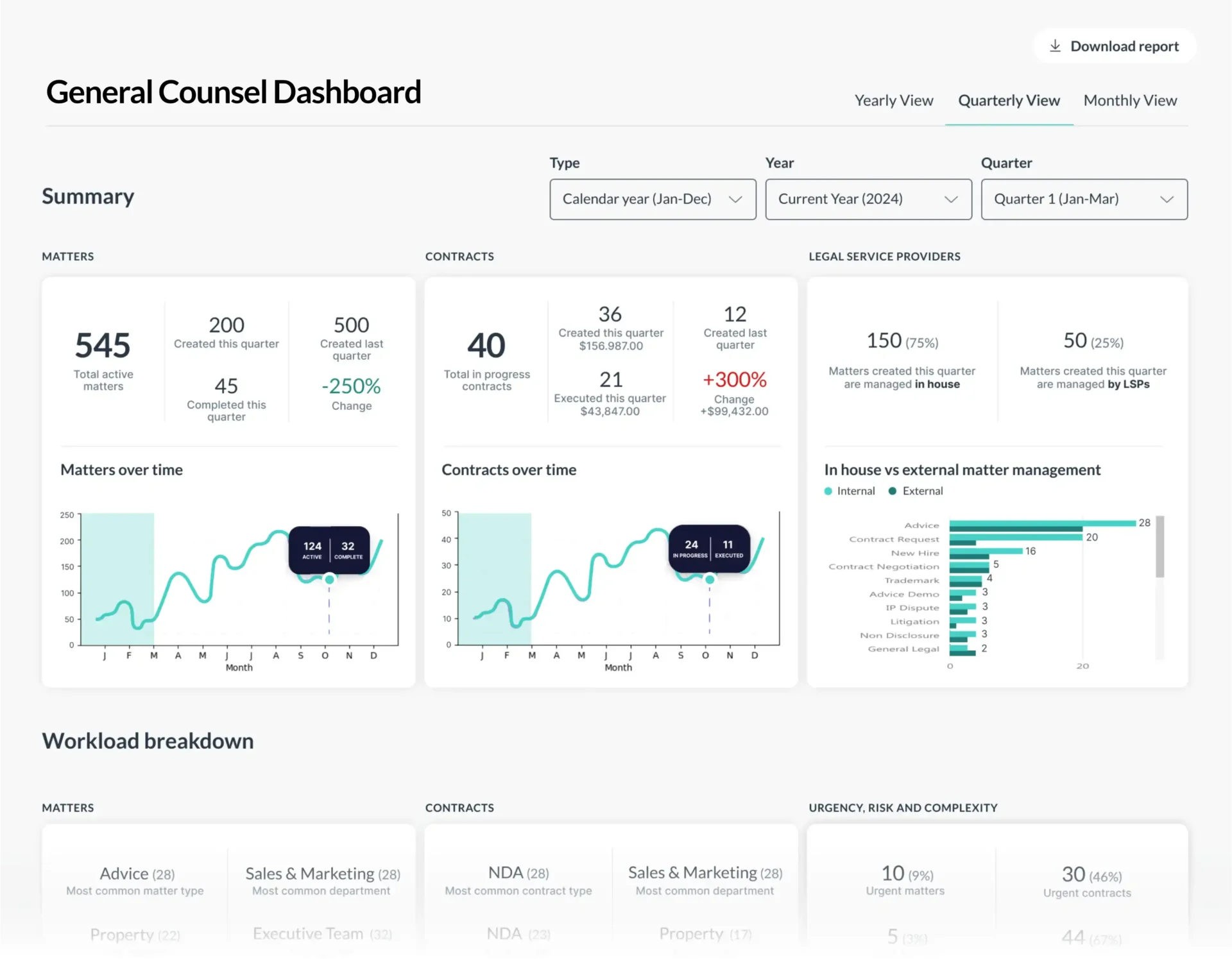5 contract management metrics your legal team should be using (and why)

There’s an untapped goldmine of legal contract management data, metrics and insights sitting just below the surface of your daily legal work.
Contract management is a central component of the in-house legal function, and a key point of convergence between legal and the wider business. With up more than 96 percent reporting managing core legal functions like contract management, compliance, invoice review, and legal operations internally, this indicates a clear preference for handling these essential matters with direct control and potentially deeper expertise and oversight within the legal team.
It’s therefore no surprise that contract management solutions, many of which include a reporting functionality, consistently rank as the number one technology solution sought out by in-house legal departments (ACC 2025 CLO Survey Key Findings).
Despite this, contract management data remains an unused resource for many legal teams, with a wealth of actionable insights going by the wayside as a result. Read on to learn why unleashing the power of legal contract management data should be an essential strategic step, not only for your in-house legal function but also for your wider business – and the five most useful contract metrics to start you on your journey.
Legal contract management – an untapped goldmine of data
Contract management data can tell you a lot about what is going on behind the scenes of your in-house legal department. Regardless of your organization’s size or industry, contracts contain information vital to your client and business relationships, internal resourcing and risk management strategy – not to mention your balance sheet. Unlocking this data is an essential step in understanding past trends, optimizing your present legal function, and influencing business outcomes going forward.
Here are some of the benefits to be gained by unlocking your contract management data:
Improve visibility
If your contract management vendor offers a feature or service that helps you import historical data into the system quickly (either through bulk upload or AI driven processes), you can start building a central system of record and access historical contract management data from day one. Features like AI contract extraction and easy to use reporting dashboards can be used to build further visibility into your contract turnaround times, which in turn will help you to identify common roadblocks and prioritize your workload and communicate with business partners about key areas or statuses of legal’s workload.
Make informed decisions
Once you gain visibility over your data repository, a clearer picture will start to emerge of your contract portfolio – including value, common sticking points, and procedural bottlenecks. This information can be an immediate cost saver – for example, by gaining visibility into upcoming contract renewals, you can immediately take a more proactive approach to your contractual obligations, ensuring that no upcoming deadline is missed.
If you can access downloadable reports, these will make it easy to get key data takeaways in front of relevant stakeholders across your organization. As your repository grows, it will become an increasingly valuable tool for forecasting future risk and opportunities.
Justify legal spend
Because the work carried out by the legal function is traditionally less likely to be quantified than in other areas of the business, it can often be undervalued, leaving the department to be misconstrued as a cost center. Contracts are a key source of value and risk for your organization – and providing insight into how your team mitigates and optimizes these through its contract workflow will help you to make smart budgeting and investment decisions, answer tough questions from leadership, and justify your team’s headcount.
Improve transparency
When it comes to contract workflows, legal is often perceived as a roadblock – which can become a major source of frustration for other business functions who may not understand why a contract cannot always be turned around on the spot. Contract lifecycle metrics are key to showcasing the value that legal brings to the business – shining a light on negotiations that go on behind closed doors to finalize key deals can be pivotal in cultivating a more harmonious relationship with the wider business. More specifically, reports such as ‘contract turnaround time’ can help you pinpoint specific sticking points and opportunities to fix them as well as setting and monitoring SLAs.
Five contract management metrics you should be using
When you consider the advantages that contract management data can bring to the legal function, the strategic value of unlocking it becomes obvious. So without further ado, here are the five most valuable legal contract management metrics you should be using:
1. Types and volume of contracts
Obtaining a clear picture of the type and volumes of contracts being processed by your legal team (as well as how many of each you are dealing with, and from which sources) is crucial in order to understand where your time and resources are being spent. This information can be used to better manage capacity, identify areas for potential automation, and pinpoint where specialist training or outsourcing is needed.
2. Contract lifecycle status
Having a dashboard which provides a picture of your work at every stage of the contract lifecycle at any given time is a valuable resource. From the draft and negotiation stages through to approval, signing, execution, and expiration, a snapshot of how your contracts are progressing allows you to prioritize, push through roadblocks, and deliver proactive updates to the wider business.
3. Contract response and turnaround times
As perhaps the most visible metric when it comes to your relationship with the wider business, contract cycle times are key to monitoring and optimizing the efficiency of your legal team. By capturing dates of creation and completion, you can track which contract types are typically turned around quickly, and which are causing bottlenecks. Tougher deals which take more time to finalize can easily become more conspicuous to colleagues than those which are completed fast, and showcasing how much your team is actually achieving can be a great way to release the pressure valve.

4. Risk vs value
When your team is constantly overwhelmed by a never-ending stream of requests from multiple areas of the wider business, it’s easy to lose track of which deals need the most attention. If your contract lifecycle management solution offers the ability to flag contracts according to risk and value, the resulting reports can signal whether the time you are spending is proportionate, allowing you to refocus your efforts on the areas where most is at stake.
5. Self-service vs supported work
Some workspace solutions offer support features to help you manage your contract workflow. Tools like self-service contract creation, customizable templates and AI powered contract data extraction can speed up your turnaround time by shifting low-risk contract tasks to other areas of the business.
If your contract lifecycle management solution includes a self-service capability, this will allow you to offer contract templates and automated workflows to other business functions, empowering them to negotiate and finalize straightforward contracts without over-reliance on legal. This will provide you with valuable comparative data to measure output, overall service to the business, and opportunities to introduce further optimizations.
If you are not yet using these features, usage data from the self-service resources you do have in place (such as FAQs) can help identify where contract templates and automated tools might be worth implementing in the future.
Elevate the value of your contract management metrics with a workspace approach
Even if you are collecting data and surfacing the right contract lifecycle metrics, there’s a good chance that the process is manual and time consuming. In order to collate a complete dataset which offers meaningful insights, you may well find yourself having to compile information across multiple systems.
Fortunately, there is an alternative approach – one that relies on a consolidated system, such as a legal workspace. With that said, let’s unpack how a legal workspace approach can be a game changer in terms of the way that you access and interpret data – as well as the metrics and insights you can glean from it.
Ease of use
In order to be valuable, the contract data that you are surfacing needs to be presented in a way that is readily accessible and easy to understand. Whilst many in-house teams are starting to adopt tech solutions for insights and reporting, 30 percent are still spending an average of three hours per day compiling assets needed for this (The 2024 In-house Legal Technology Report).
This is a significant time and resource drain – and one that can be easily resolved by adopting a legal workspace, such as LawVu, which offers simple visual dashboards and out-of-the-box reporting capabilities.
For your very own walk-through of reporting and insight capabilities including contract management data in the LawVu legal workspace, click here.

Integrated data set
While contract management makes up a significant proportion of the work in-house legal functions do, they are only one part of the story – matter management and spend management are key pieces of the puzzle too.
A significant advantage of a legal workspace approach is the elevated insight that comes with a consolidated solution. If your contract management data is fully integrated with matters and spend, your metrics will start to deliver a more comprehensive picture – for example, by offering visibility into the status and volume of matters by contract type and stage, along with external legal spend by matter type, team and region. The General Counsel Dashboard is a great example of having all the key insights and data you need at your fingertips.

After all, if you want to reliably inform your operational, risk management, and resourcing strategies, context is everything. How can you make accurate budget or capacity decisions for your legal department if you are reporting on contracts in silo from your other workflows?
While there’s no denying that drawing on contract management metrics in the first instance is a step in the right direction to becoming a data-driven legal function, it’s important to remember that the value of your data will always be limited by how easy it is to access and interpret – and that contracts alone will only provide insight into one component of the work your team does.
So, if you’re in the market for a contract management solution and are now curious about unlocking the data-driven insights sitting beneath the surface of your legal team’s work, you may want to consider the value of a consolidated solution or legal workspace such as LawVu.
Ready to learn more about legal contract management data?
We hope that this rundown of the five essential contract management metrics for the in-house legal function inspires you to unleash the benefits of contract management data as part of a consolidated legal workspace for your own team – and for your wider organization!
To learn more about how a workspace approach to legal contract management can help you save time, deliver better outcomes, and showcase the value of legal to your business with actionable data-driven insights, click here.
